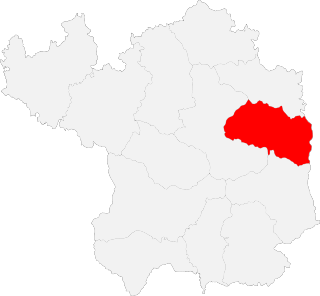
PetroChina Company Limited is a Chinese oil and gas company and is the listed arm of state-owned China National Petroleum Corporation (CNPC), headquartered in Dongcheng District, Beijing. The company is currently Asia's largest oil and gas producer. Traded in Hong Kong and New York, the mainland enterprise announced its plans to issue stock in Shanghai in November 2007, and subsequently entered the constituent of SSE 50 Index. In the 2020 Forbes Global 2000, PetroChina was ranked as the 32nd-largest public company in the world.

China Petroleum & Chemical Corporation (中国石油化工股份有限公司), or Sinopec, is a Chinese oil and gas enterprise based in Beijing. It is listed in Hong Kong and also trades in Shanghai.

Marathon Oil Corporation is an American company engaged in hydrocarbon exploration incorporated in Ohio and headquartered in the Marathon Oil Tower in Houston, Texas. A direct descendant of Standard Oil, it also runs international gas operations focused on Equatorial Guinea, offshore Central Africa.

Kunlun Energy Limited, formerly CNPC Limited, became a Hong Kong-listed company in 1993 through a backdoor listing. Its parent company is the China National Petroleum Corporation which itself was created from the transformation of the Ministry of Petroleum Industry in the People's Republic of China in 1988. It is engaged in the investment of exploration, development and production of crude oil and natural gas in China, Kazakhstan, Oman, Peru, Thailand, Azerbaijan and Indonesia.
CNOOC Limited (中国海洋石油有限公司) is China's largest producer of offshore crude oil and natural gas, noted as such in 2010. It is a major subsidiary of China National Offshore Oil Corporation (CNOOC) and has been listed in Hong Kong SEHK: 883 since February 2001. It was listed on the New York Stock Exchange from 2001 to 2021. It was on the Toronto Stock Exchange between 2013 and 2021. It was admitted as a constituent stock of the Hang Seng Index in July 2001.
PetroKazakhstan is a Canadian oil company, based in Calgary, Alberta, that has all of its business focused on Kazakhstan where it had some 550 million barrels (87,000,000 m3) of oil and 25 billion cubic feet (710,000,000 m3) of natural gas reserves in the Turgai basin region. These are the second largest Kazakhstani proven reserves after ChevronTexaco's TengizChevroil. Estimated production is 165,000 barrels (26,200 m3) of oil per day. In 2005, PetroKazakhstan was acquired by China National Petroleum Corporation and then in 2006 transferred to PetroChina.
Talisman Energy Inc. was a Canadian independent petroleum company that existed between 1993 and 2015. The company was created from the assets of BP Canada after British Petroleum divested its 57 percent stake in June 1992. It was one of Canada's largest independent oil and gas companies, and operated globally, with operations in Canada and the United States of America in North America; Colombia, South America; Algeria in North Africa; United Kingdom and Norway in Europe; Indonesia, Malaysia, Vietnam, Papua New Guinea, East Timor and Australia in the Far East; and Kurdistan in the Middle East. Talisman Energy has also built the offshore Beatrice Wind Farm in the North Sea off the coast of Scotland.

The China National Petroleum Corporation (CNPC) is a major national oil and gas corporation of China and one of the largest integrated energy groups in the world. Its headquarters are in Dongcheng District, Beijing. CNPC was ranked fourth in 2022 Fortune Global 500, a global ranking of the largest corporations by revenue.

The Hong Kong and China Gas Company Limited, doing business as Towngas, is the sole provider of territory-wide town gas in Hong Kong. Founded in 1862, it is one of the oldest listed companies in the territory.
The West–East Gas Pipeline is a set of natural gas pipelines which run from the western part of China to the east.

The Abu Dhabi National Oil Company or ADNOC is the state-owned oil company of the United Arab Emirates (UAE).

QatarEnergy, formerly Qatar Petroleum (QP), is a state owned petroleum company of Qatar. The company operates all oil and gas activities in Qatar, including exploration, production, refining, transport, and storage. The President & CEO is Saad Sherida al-Kaabi, Minister of State for Energy Affairs. The company's operations are directly linked with state planning agencies, regulatory authorities, and policy making bodies. Together, revenues from oil and natural gas amount to 60% of the country's GDP. As of 2018 it was the third largest oil company in the world by oil and gas reserves. In 2022, the company had total revenues of US$52bn, a net income of US42.4bn, and total assets of US$162bn. In 2021, QatarEnergy was the fifth largest gas company in the world.

Mongolia Energy Corporation Limited (MEC) is a mining and energy development holding company operating in Mongolia and Xinjiang in northwestern China. It was incorporated in Bermuda and listed on the Hong Kong Stock Exchange. MEC became a constituent to the MSCI Hong Kong Index from June 2008.

Mercuria Energy Group Ltd is a Cypriot-domiciled Swiss multinational commodity trading company active in a wide spectrum of global energy markets including crude oil and refined petroleum products, natural gas, power, biodiesel, base metals and agricultural products. The company is one of the world's five largest independent energy traders and asset operators and is based in Geneva, Switzerland, with 37 additional offices worldwide. The group operates in 50 different countries.

China Petrochemical Corporation or Sinopec Group is the world's largest oil refining, gas and petrochemical conglomerate, administered by SASAC for the State Council of the People's Republic of China. It is headquartered at Chaoyangmenwai in Beijing, across the road from the headquarters of fellow state-owned oil company and competitor CNOOC Group.

The impact of the petroleum industry has been increasing globally as China ranks seventh for oil production and second in crude oil consumption in the world.

Yanchang County is a county under the administration of the prefecture-level city of Yan'an, in the northeast of Shaanxi Province, bordering Shanxi Province across the Yellow River to the east. It has a land area of 2,368.7 square kilometres (914.6 sq mi), and a population of 158,000.

Although there are numerous oil companies operating in Canada, as of 2009, the majority of production, refining and marketing was done by fewer than 20 of them. According to the 2013 edition of Forbes Global 2000, canoils.com and any other list that emphasizes market capitalization and revenue when sizing up companies, as of March 31, 2014 these are the largest Canada-based oil and gas companies.

Addax Petroleum was established in 1994 and since August 2009, has been a subsidiary of the Sinopec Group, one of the largest oil and gas producers in China, the biggest oil refiner in Asia and the third largest worldwide. Addax Petroleum was an international gas and oil production and exploration company mainly focused on the Middle East, the North Sea and Africa. Since its founding, the company has become one of the largest oil producers in West Africa.

China National Offshore Oil Corporation, or CNOOC Group, is one of the largest national oil companies in China, and the third-largest national oil company in China, after CNPC and China Petrochemical Corporation. The CNOOC Group focuses on the exploitation, exploration and development of crude oil and natural gas in offshore China, along with its subsidiary COOEC.
















